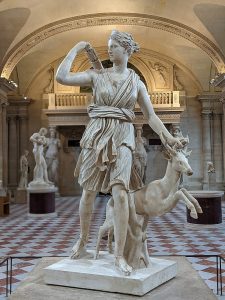
Greek Goddess of the Hunt, Wilderness, and Feminine Power
In the pantheon of Greek mythology, few deities capture the imagination quite like Artemis. Known as the goddess of the hunt, wilderness, wild animals, and the moon, Artemis embodies strength, independence, and the untamed spirit of nature. Her stories resonate with themes of protection, purity, and ferocity, making her one of the most revered and complex figures in ancient lore. This article delves into her origins, symbolism, myths, and enduring legacy.
Origins and Family: Daughter of Zeus and Protector of the Young
Artemis was the daughter of Zeus, king of the gods, and Leto, a Titaness. Alongside her twin brother Apollo (god of the sun, music, and prophecy), she was born on the secluded island of Delos—a refuge her mother sought after being relentlessly pursued by Hera, Zeus’s jealous wife. Even in infancy, Artemis displayed her fierce nature, assisting Leto during Apollo’s birth shortly after her own.
From childhood, Artemis defied traditional feminine roles. She petitioned Zeus for eternal chastity, a silver bow and arrows, the freedom to roam forests, and a retinue of nymphs to accompany her. These gifts solidified her identity as a maiden goddess who rejected marriage, instead devoting herself to the wilderness and safeguarding women, children, and animals.
Symbols and Domains: The Moon, Bow, and Wild Realm
Artemis is often depicted as a youthful huntress, clad in a short tunic with a quiver on her back and a bow in hand. Key symbols associated with her include:
– The Crescent Moon: As a lunar deity, she shares a celestial connection with her brother Apollo (the sun). Her link to the moon underscores her role in guiding night travelers and influencing cycles of life.
– Bow and Arrows: Tools of both protection and punishment. Artemis wielded them to defend sacred spaces or mete out divine justice.
– Deer and Hunting Dogs: These animals represent her mastery over the hunt and her harmonious yet dominant relationship with nature.
– Cypress Tree: Sacred to Artemis, it symbolized eternal vitality and the untamed wild.
Artemis’s dual nature—nurturer and destroyer—made her a paradox. She was a protector of young girls and women in childbirth, yet she could unleash plague or sudden death on those who offended her.
Myths and Legends: Power, Wrath, and Mercy
Artemis’s myths highlight her uncompromising values and formidable presence. Among the most famous stories:
Actaeon’s Fate: A Warning Against Hubris
The hunter Actaeon stumbled upon Artemis bathing in a sacred spring. Enraged by his intrusion, she transformed him into a stag, and his own hounds tore him apart. This tale reinforced boundaries between mortals and the divine, emphasizing respect for Artemis’s sanctity.
Orion: Friendship and Tragedy
Artemis’s close bond with the giant hunter Orion sparked varying myths. Some say she accidentally killed him after a challenge from Apollo; others claim Orion’s arrogance led to his downfall. In all versions, Artemis placed him among the stars as the constellation Orion, immortalizing their connection.
The Niobe Punishment: Defending Her Mother’s Honor
When Queen Niobe boasted of surpassing Leto in motherhood, Artemis and Apollo avenged their mother by slaying Niobe’s children. The myth underscores Artemis’s loyalty and the consequences of hubris.
Worship and Cultural Impact
Artemis’s influence extended far beyond mythology. She was venerated across the ancient world, most notably at the Temple of Artemis in Ephesus(one of the Seven Wonders of the Ancient World). Here, she was worshipped as a fertility goddess, depicted with multiple breasts symbolizing nourishment.
Festivals like the Brauronia in Athens honored her role in childbirth and youth. Young girls performed rituals as “little bears” to prepare for adulthood, reflecting Artemis’s guardianship over transitions in life.
Artemis’s Legacy: Femininity, Freedom, and Modern Resonance
Artemis’s archetype—a woman unbound by societal expectations—resonates powerfully today. She is celebrated as a feminist icon, embodying autonomy, resilience, and the rejection of patriarchal norms. Modern literature, art, and media frequently draw inspiration from her:
– Literature: Rick Riordan’s Percy Jackson series portrays her as a steadfast leader of the Hunters.
– Astronomy: NASA’s Artemis Program, aiming to return humans to the moon, pays homage to her lunar association.
– Environmental Movements: Her connection to nature inspires advocacy for wildlife conservation.
Even her Roman counterpart, Diana, retains her core attributes, proving the timelessness of her myth.
Huntress Girl
Artemis’s enduring appeal lies in her complexity—she is both gentle and ruthless, a guardian and a warrior. Her stories remind us of the power of nature, the importance of boundaries, and the strength found in independence. Whether through ancient rituals or modern symbolism, Artemis continues to inspire those who seek courage, freedom, and a deeper connection to the wild.
Explore more Greek mythology to uncover how these ancient tales still shape our understanding of humanity, nature, and the divine.